Physical Address
304 North Cardinal St.
Dorchester Center, MA 02124
Secondary nasal deformities are not limitless but group into three patterns that can be anticipated in the primary nose – therefore their solutions follow patterns.
The most common motivation for secondary surgery is an iatrogenic deformity from prior rhinoplasty.
All key planning decisions can be made from the nasal surface and follow one of two surgical plans. Each anatomical point translates directly to a diagnosis and then to a surgical step: the entire rhinoplasty strategy can be set preoperatively.
Only four common anatomical traps predispose to secondary deformities: (1) low radix or low dorsum; (2) inadequate tip projection; (3) narrow middle vault; (4) alar cartilage malposition (cephalic rotation).
Reconstruction of both internal and external valvular incompetence triples or quadruples airflow in most patients without concomitant septoplasty or turbinectomy.
The great majority of primary nasal deformities can be corrected with only one of two operative strategies depending on the relationship of dorsal height to lower nasal size: radix, spreader, and tip grafts; or dorsal and tip grafts. Alar wall grafts are needed if the external valves are unstable. Thus the surgeon need only learn four techniques to perform most rhinoplasties.
Reconstruct anatomically (i.e., simulating ideal anatomy), never forgetting function and always considering the patient's own aesthetic.
Most intraoperative and postoperative problems are under the surgeon's control.
Effective patient selection is mandatory; adverse childhood experiences can create body shame and therefore affect postoperative satisfaction.
Access video lecture content for this chapter online at Elsevier eBooks+ ![]()
Rhinoplasty is uniquely difficult and uniquely rewarding, but some excellent surgeons stop performing rhinoplasty because they lose confidence in their abilities or follow techniques that are too complex. This need not be the case. The goal of this chapter is to outline a system of understanding and treating nasal deformities that is based on functional analysis, knowledge of critical anatomical variants, soft-tissue and skeletal behavior, and a surgical philosophy that emphasizes safety and function, and that primarily relies on only four techniques that always work if performed correctly.
The advocates of open rhinoplasty argue that open rhinoplasty is easier than the endonasal approach because the surgeon has better diagnostic ability and superior access to the underlying anatomy. If the surgeon produces a perfect skeletal shape, the result will be perfect. If that is true, however, why does supratip deformity occur ( Fig. 20.1 )? The answer is that the nasal skin is not a tablecloth but rather has its own vectors of contraction and tissue limits. If the surgeon exceeds those limits, the external result will not reflect the skeletal shape.
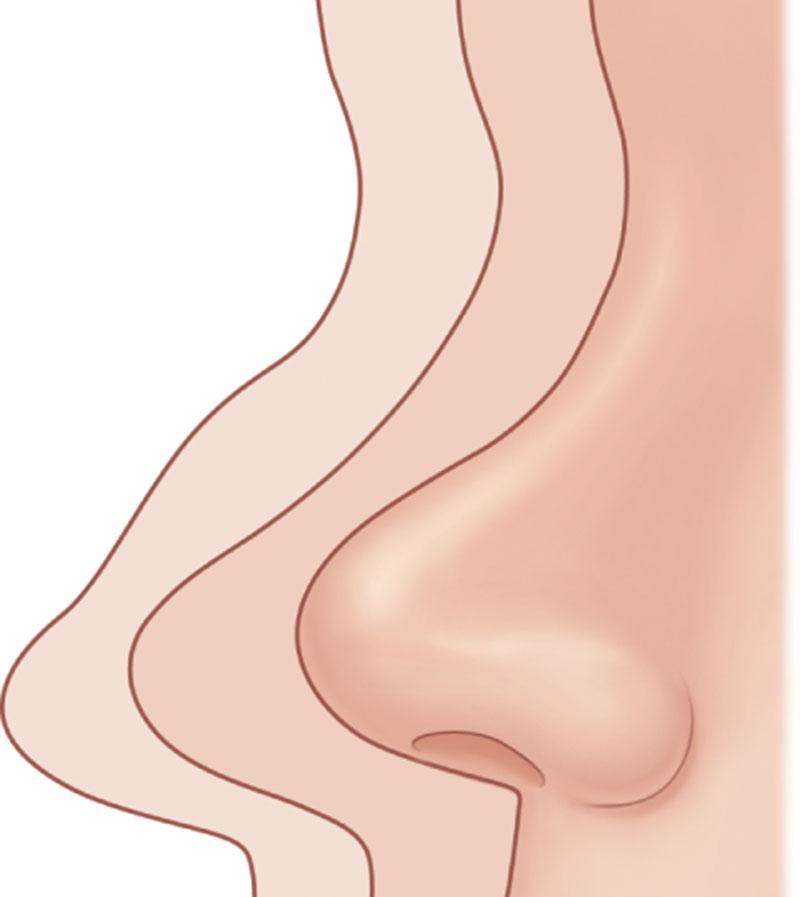
Endonasal rhinoplasty is not open rhinoplasty performed through worse access. The mindset is different, like the difference between liposuction and abdominoplasty. Why perform endonasal rhinoplasty? Because it is easier.
Dissection is directed and confined only to those areas important to the patient’s goals, limiting morbidity and the possibility of iatrogenic deformities.
Fewer techniques need to be mastered – in many cases I only use four. Internal sutures and struts, often required only to counteract damage done by the exposure, are not required.
Most importantly, the surgeon sees better through the endonasal approach . Half of nasal shape is imparted by the skin. The surgeon who chooses the open approach therefore forfeits surface feedback – 50% of the intraoperative information that the nose can provide. The open rhinoplasty surgeon sees the skeleton well, but the skin surface inaccurately. The closed rhinoplasty surgeon sees and benefits from both.
It is therefore more accurate to say that rhinoplasty is difficult because the nasal soft tissues have limited contractility; because nasal regions are structurally and functionally interrelated, not independent; the operation is dynamic and interactive; and because rhinoplasty is a right-brain operation. Modern rhinoplasty therefore becomes an operation of reduction, augmentation, and equilibration – still challenging, but easier when viewed in the context of a model that considers both function and aesthetics and prescribes techniques that modify them together.
Rhinoplasty is probably the most right-brain operation that plastic surgeons perform. Unfortunately, our educational system cultivates the verbal, rational, analytical, and numerical left side of the brain, tending to ignore the right side, so that most adults draw with the same level of sophistication that they possessed as 10-year-old children, not coincidentally the age at which the left brain becomes dominant. The ease with which surgeons can perform rhinoplasty is greatly facilitated by good right-brain function.
The most attractive noses in nature do not look assembled but unified: every part seems to belong. The same principle should apply to rhinoplasty results. The beauty of the finished surgical product depends on an ability to see the preoperative excesses and deficiencies in shape and proportion without preconceptions; balance them against the patient's surgical goals; and from then create an effective surgical plan. Right-brain function can be cultivated by analytic exercises and by studying silhouettes of patient profiles.
The fact that many post-rhinoplasty nasal configurations, and all “end-stage” noses, look the same is not a coincidence. The response of any nasal skeleton and its investing soft tissues to reduction is not idiosyncratic but consistent and therefore predictable. These forces collapse the upper nose caudally and medially over the pyramidal bony and upper cartilaginous vaults, cephalad at the columella, posteriorly over the maxillary arch, and posteriorly and concentrically around the tip lobule, exemplifying a “deformity from soft-tissue contraction” (see Fig. 20.1 ). Whether the nasal skeleton has been reduced by surgery, trauma, congenital anomalies, or granulomatosis with polyangiitis (Wegener's granulomatosis), the essential external appearance appears the same. Variations occur because of disequilibrium between skeletal and soft-tissue volumes or differences in soft-tissue thickness and elasticity, not because biologic forces differ from patient to patient.
Preoperative nasal shape represents not a static structure but rather a dynamic equilibrium, the sum of balanced, opposing forces between the nasal soft tissues and their underlying support. At the start of a rhinoplasty, the nose is equilibrated. Skeletal reduction disrupts this equilibrium. Soft-tissue and skeletal contraction occurs until the nose re-establishes another equilibrium when contraction can no longer occur. The degree of soft-tissue/skeletal and skeletal/skeletal disequilibrium at the end of the procedure determines the amount of contraction that will occur postoperatively and whether the surface reflects the surgeon’s skeletal reconstruction: the bigger the disequilibrium, the bigger the postoperative surprise. The surgeon therefore ideally controls the postoperative shape by permitting soft-tissue contraction only where it is most predictable (e.g., over the bony and cartilaginous dorsa) and by minimizing contraction where it is less predictable (e.g., the lower nasal third). The surgeon who controls the intraoperative equilibrium controls the postoperative result.
The nose behaves structurally as a system of two interrelated layers ( Fig. 20.2 ). The outer layer, like an elastic sleeve, slides over the inner semi-rigid layer and contains the entire investing nasal soft tissues plus the alar cartilages and their associated lining. The inner layer contains everything else (the bony and upper cartilaginous vaults, the nasal septum, and their associated linings). This two-layer concept associates those structures that behave together anatomically and functionally, and provides an explanation for the “global” manifestations of some surgical changes (e.g., why noses usually shorten when the dorsum is reduced and lengthen when the dorsum is raised).
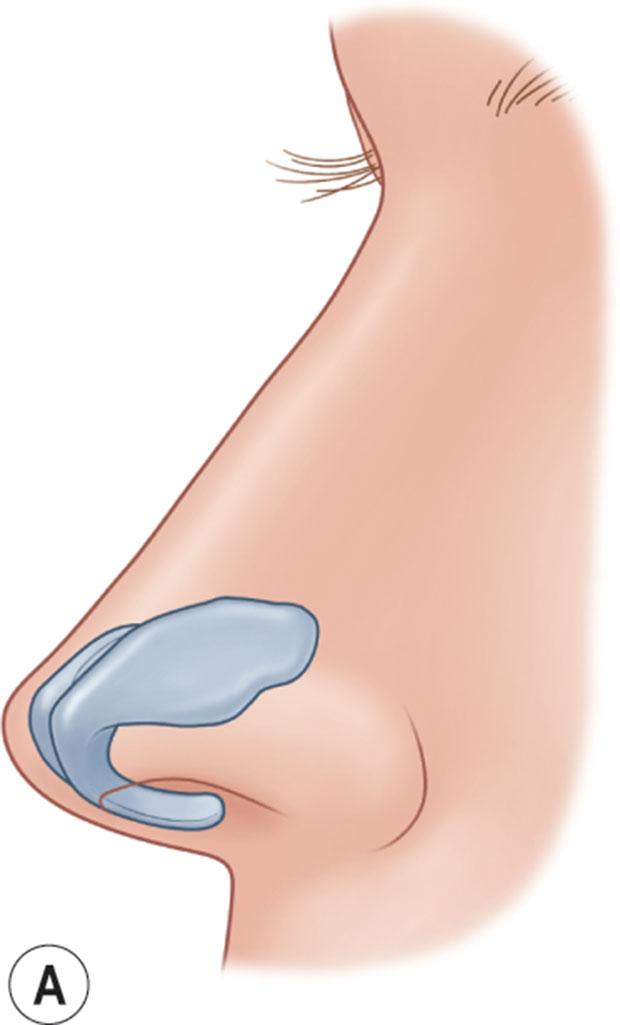
The width and stability of the upper cartilaginous vault (formed by the upper lateral cartilages and the anterior septal edge), the critical area of the internal nasal valves, depends on the width of the bony vault and the height and width of the middle vault roof. Resection of the middle vault roof more than 2 mm during hump reduction removes this critical laterally-distracting, stabilizing force on the upper lateral cartilages, which can now fall medially and produce the characteristic “inverted-V” deformity signifying obstructive narrowing at the internal valves, and cutting preoperative airflow by 50% (see “The Effect of Rhinoplasty on the Airway”, below). Middle vault collapse virtually always occurs when the cartilaginous roof has been resected, whether or not osteotomy has been performed, but may not be visible if the overlying soft tissues are sufficiently thick; however, when the nasal skin is thin, the deformity can be impressive ( Fig. 20.3 ). To avoid middle vault collapse and internal valvular incompetence, the surgeon should plan to reconstruct the normal forces by a substantial dorsal graft or by spreader grafts, which provide the same degree of functional mean nasal airflow improvement as documented by a level II outcome study (see below).
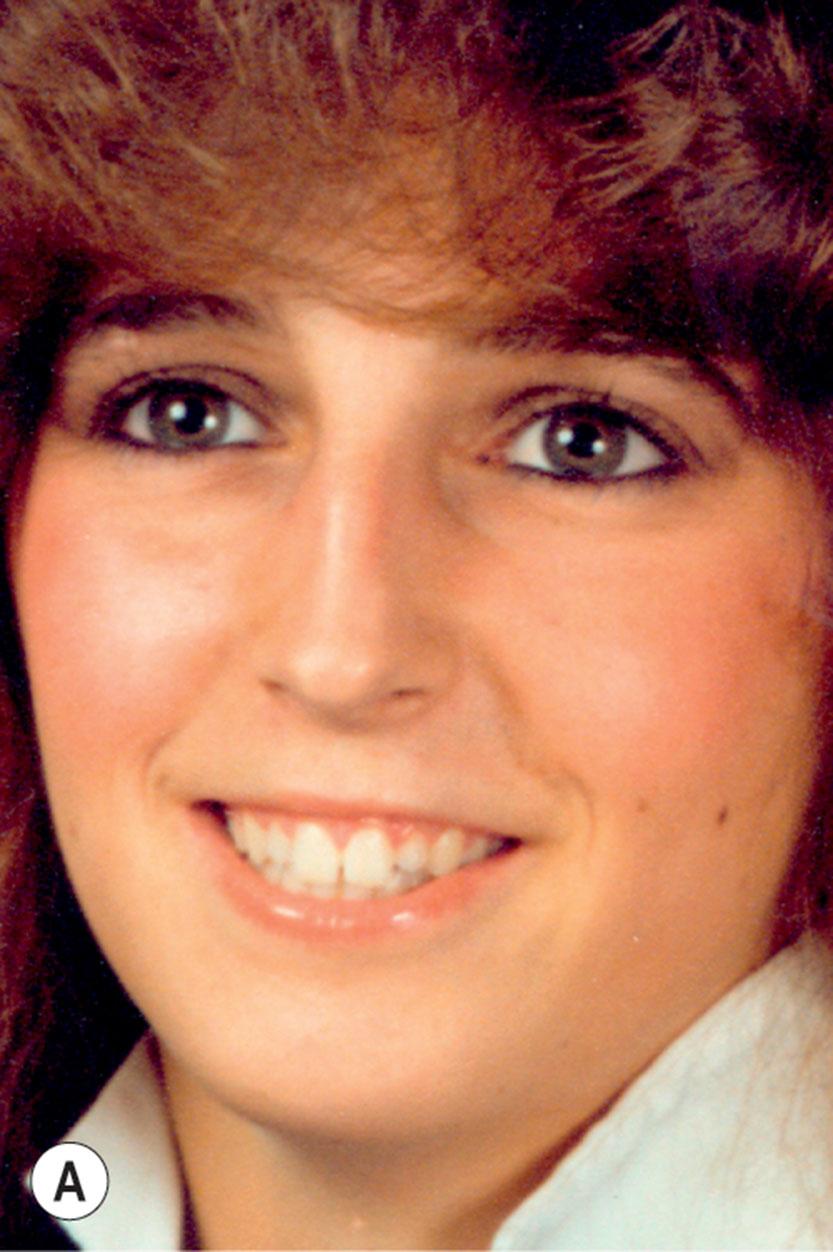
The upper lateral cartilages are supported caudally by their relationship to the cephalic margins of the lateral crura in the region of the so-called “scroll”; radical alar cartilage resection can compromise middle vault support and may leave an external deformity typified by deepening and lengthening of the alar creases. In my practice I resect the upper lateral cartilages submucosally only when failure to do so would allow them to prolapse into the airway or when necessary to shorten the nose.
The point of intersection of the upper and lower lateral cartilages creates the “watershed” area between the internal and external nasal valves, and aggressive surgery in this area also affects external valvular competence, particularly in patients whose alar cartilage lateral crura are cephalically rotated. Both caudal support by the lower lateral cartilages and anterior support provided by the intact cartilaginous roof are profoundly critical to airway function.
Tip projection is the intrinsic ability of the alar cartilages to support the tip lobule independent of dorsal height and depends on alar cartilage middle crural size, shape, and substance ( Fig. 20.4 ). No patient can have a straight profile line without adequate tip projection; that is its importance. Tip projection is not a reflection of nasal base size (i.e., skin volume) but rather the length and substance of the alar cartilage middle crura, a distinction that is not always understood. Tip projection reflects cartilage strength, not skin volume .
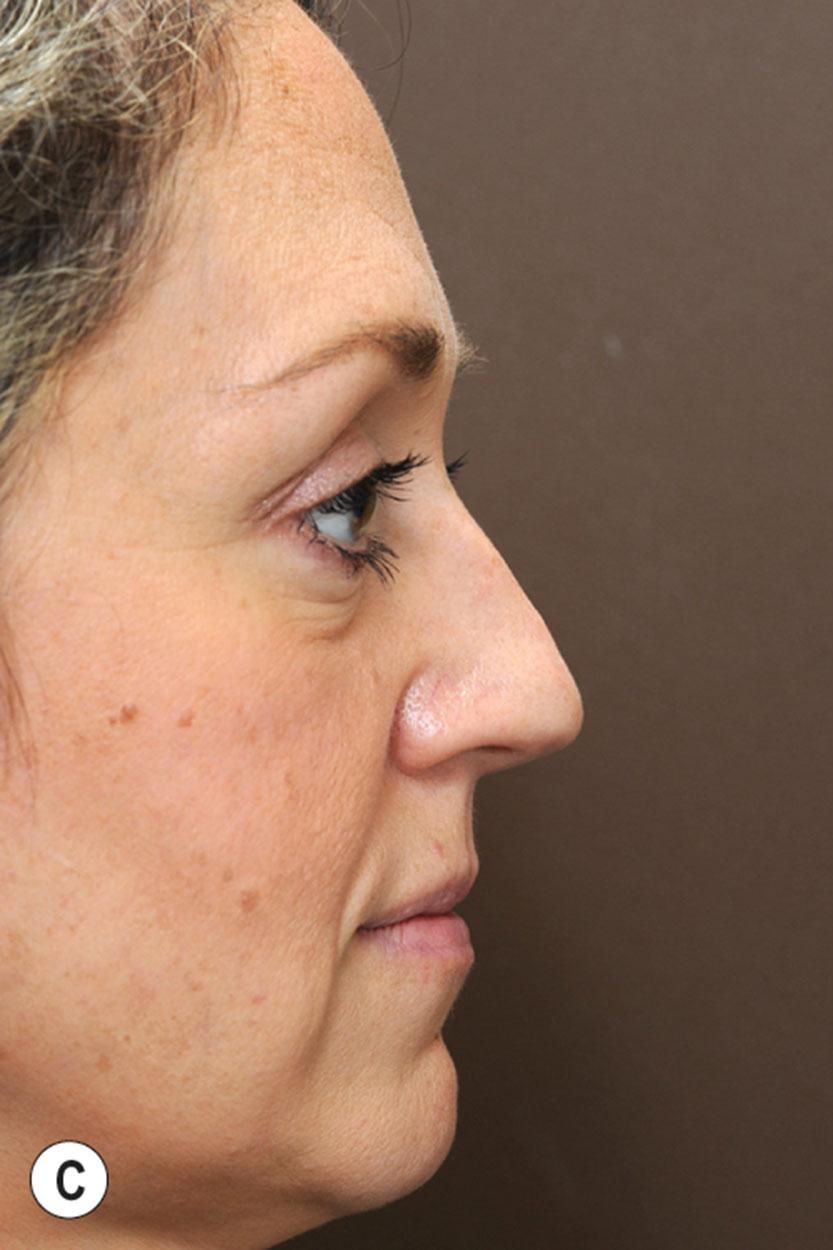
Tip projection extremes are the easiest to identify. Nasal tip position in Fig. 20.4A ![]() depends on bridge height; therefore, tip projection will decrease when the dorsum is resected. Conversely, the nasal tip in Fig. 20.4B
depends on bridge height; therefore, tip projection will decrease when the dorsum is resected. Conversely, the nasal tip in Fig. 20.4B ![]() depends not on dorsal height but on new projection provided by tip grafts (no sutures or columellar strut). Inadequate tip projection cannot be rendered adequate by dorsal resection alone. The tip, the lower nasal skin, and in many patients nearly the lower half of the profile line depend on suspension of the skin sleeve by the alar cartilages, which, like a “cap” anterior to the remaining skeleton (recall the nasal layers), maintain lower nasal tension. The alar cartilages carry a larger responsibility for caudal nasal support than may at first be evident.
depends not on dorsal height but on new projection provided by tip grafts (no sutures or columellar strut). Inadequate tip projection cannot be rendered adequate by dorsal resection alone. The tip, the lower nasal skin, and in many patients nearly the lower half of the profile line depend on suspension of the skin sleeve by the alar cartilages, which, like a “cap” anterior to the remaining skeleton (recall the nasal layers), maintain lower nasal tension. The alar cartilages carry a larger responsibility for caudal nasal support than may at first be evident.
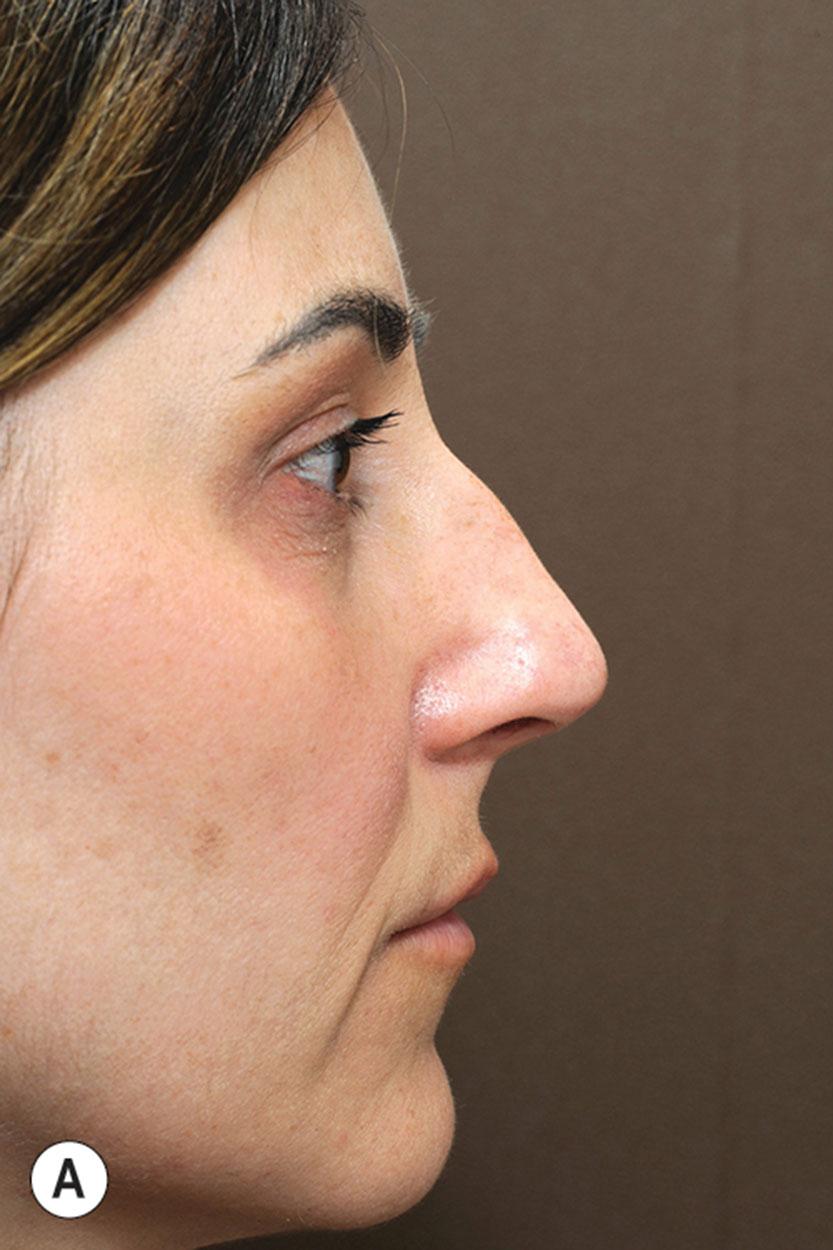
Unfavorable rhinoplasty results are not limitless: they form three recognizable patterns ( Box 20.1 ). The anatomical traps that cause these deformities can be diagnosed in the primary nose. Pattern 1 is “deformity from soft-tissue contraction”: the dominating appearance is that of a rounded, blunt nasal shape without tip projection (see Fig. 20.1 ). Pattern 2 is “deformity from skeletal contraction”, where the most striking attribute is the collapse of the skeleton in the middle third and at the alar rims, pulling the sidewalls and “nostril rims” with it (see Fig. 20.3 ). Pattern 3 is “deformity from imbalance”, where the parts of the nose do not seem right to the eye: the dorsum is either too high or too low for the lower nasal third. All three patterns are produced by failure to recognize and adequately treat four common anatomical variants that trap surgeon and patient together ( Figs. 20.5 & 20.6 ).
Deformities from soft-tissue contraction
Deformities from skeletal contraction
Deformities from imbalance
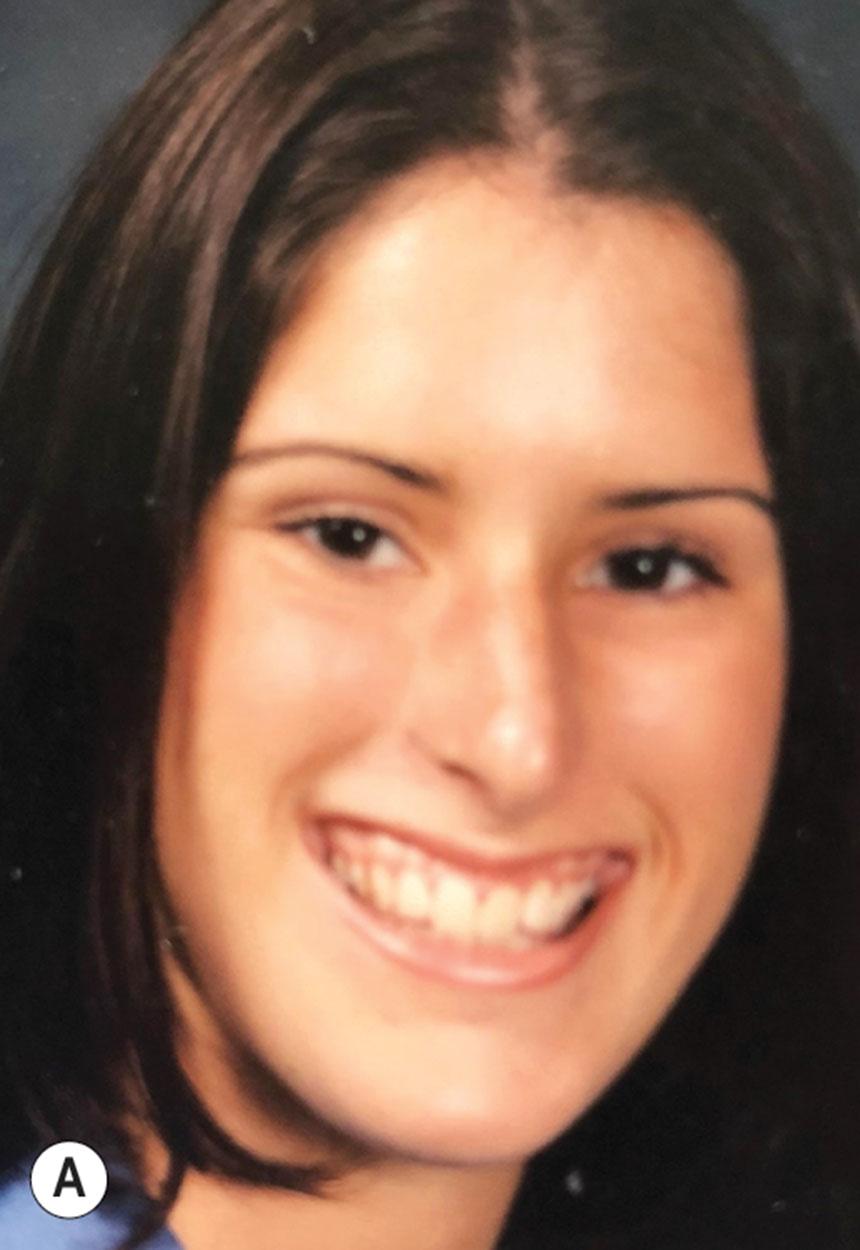
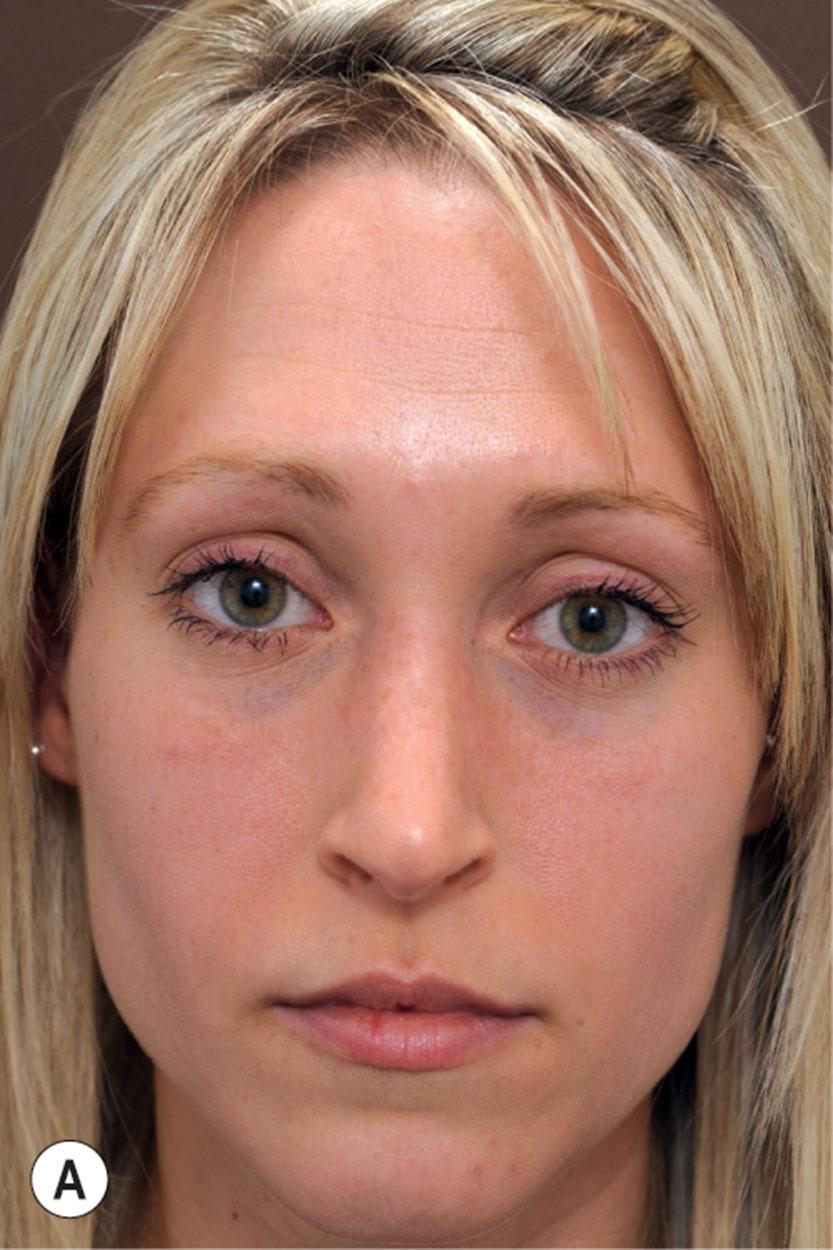
A great deal can be learned about primary rhinoplasty by observing the presenting deformities of revision rhinoplasty patients and by examining one's own unsatisfactory results. A retrospective study of 150 consecutive revision and 50 primary rhinoplasty patients suggests that only four common, normal anatomic traits in the primary nose particularly predispose to unfavorable rhinoplasty results: low radix/low dorsum, narrow middle vault, inadequate tip projection, and alar cartilage malposition. Each contributes to one of the three deformity patterns described above.
| Anatomy | Threats | Treatment | Associated secondary pattern |
|---|---|---|---|
| Inadequate tip projection | Supratip deformity | Tip grafts | Deformities from soft-tissue collapse |
| Low radix/low dorsum | Nasal imbalance | Radix/dorsal grafts | Deformities from imbalance |
| Narrow middle vault (congenital or from roof resection) | Internal valvular obstruction | Spreader grafts | Deformities from skeletal collapse |
| Malposition | External valvular obstruction (congenial malposition – cephalic rotation – or excessive lateral crural resection) | Reposition lateral crus or support collapsing segment | Deformities from skeletal collapse |
Low radix or low dorsum in most individuals of European (Caucasian) descent (there are important ethnic variations) begins caudal to the level of the upper lash margin with the patient's eyes in primary gaze; this variant was present in 93% of the secondary patients and 32% of the primary patients in the series. First described by Sheen, the low radix is one of several primary causes of nasal imbalance: an upper nose that seems too small for its lower nasal component. When the radix begins lower than the upper lash margin, dorsal length is therefore shorter and so nasal base size appears larger. The classic imbalance may take the form of the depression or notch in the upper nasal third; or a low, straight dorsum may accompany a large nasal base. The surgeon often hears: “The tip of my nose sticks out too far”(see Figs. 20.5 & 20.6 ). The surgical dilemma is as follows: If the surgeon reduces the nasal dorsum, the patient's preoperative skeletal and skin sleeve maldistribution will worsen: the lower nose will appear even larger. The surgeon fortunately has two other choices: either limit tip reduction, or raise the dorsum segmentally or entirely to balance the nasal base. Variations of the latter option are generally safer because they require less contraction of the thicker nasal base tissues. Failure to recognize the low radix or low dorsum leads to Secondary Pattern 3, “deformity from imbalance.”
A narrow middle vault (see Fig. 20.3 ; Fig. 20.7 ) is arbitrarily defined as any upper cartilaginous vault that is at least 25% narrower than the upper or lower nasal third (present in 87% of the secondary patients and 38% of the primary patients in this series). This variant was described by Sheen in conjunction with short nasal bones but has been discussed subsequently by that author and others as a trait that places the patient at special risk for internal valvular obstruction, which can exist preoperatively or may be produced by dorsal resection . Descriptions of valvular collapse had appeared earlier in the rhinoplasty literature but the missing puzzle piece had been the link between resection of the cartilaginous roof and postoperative internal valvular collapse, a phenomenon even now incorrectly attributed to traumatic or surgical avulsion of the upper lateral cartilages from the nasal bones. Resection of even 2 mm of the cartilaginous roof during hump removal ablates the stabilizing confluence that braces the middle vault, which can now collapse toward the anterior septal edge, restricting airflow at the internal valves and producing a characteristic “inverted-V” deformity. Rhinomanometric studies indicate that valvular obstruction is 4 times more common than pure septal obstruction in primary rhinoplasty patients and 12 times more common in secondary patients; reconstruction of incompetent internal valves by dorsal or spreader grafts doubles nasal airflow in most patients. Some surgeons use “spreader flaps” instead, redundant or unresected upper lateral cartilages that are turned medially and fixed to the septal edge by sutures. Although spreader flaps have become a popular alternate technique, large series airway measurements have not yet shown how they compare to spreader grafts.
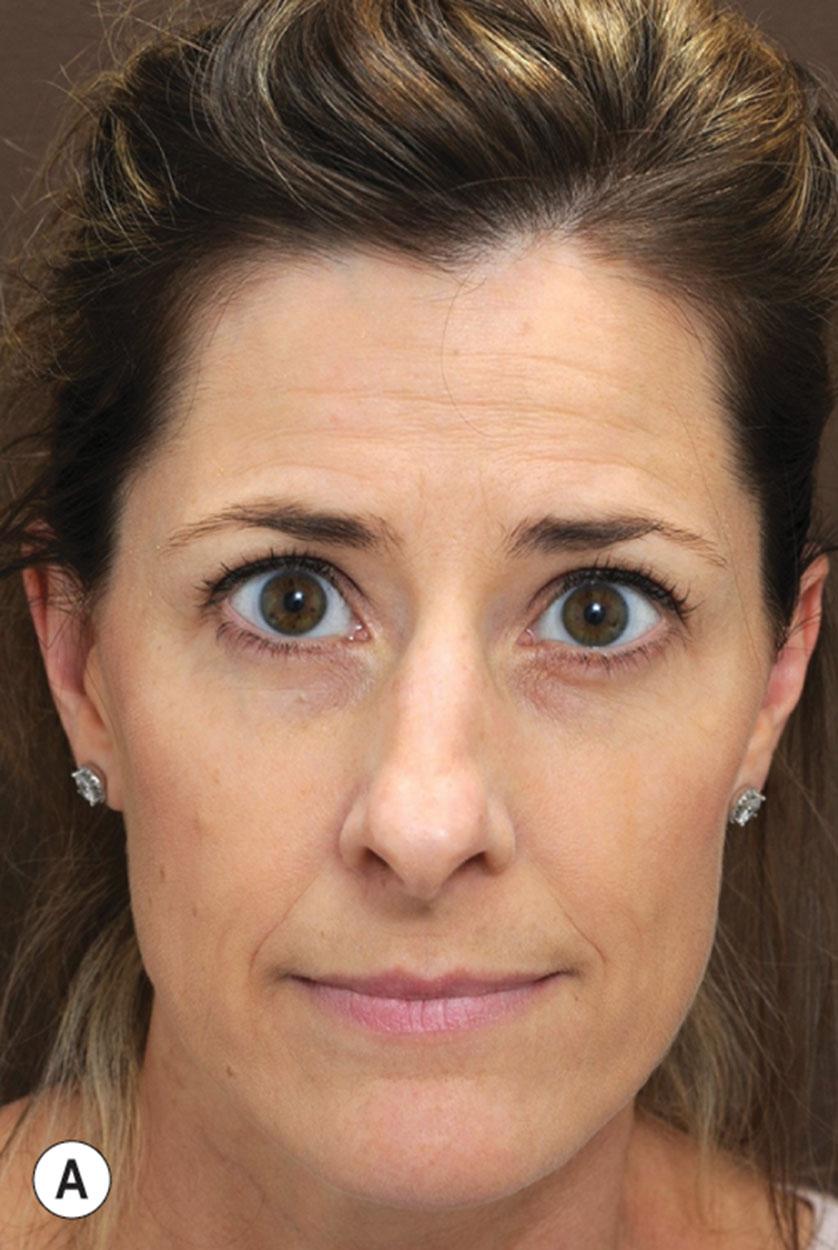
Cartilaginous roof resection and failure to recognize malposition (below) contribute to Secondary Pattern 2, “deformity from skeletal contraction” (see Table 20.1 ).
A tip with inadequate projection is defined as any tip that does not project independently of dorsal height (see Fig. 20.4A,C ). Inadequate tip projection was present in 80% of the secondary patients and 31% of the primary patients in the reported series. Despite its importance, the term “tip projection” has been used to connote different things by different authors. Some surgeons assess tip projection by measuring the distance of the most projecting point of the tip from a facial parameter, and others by the relative proportion of the nasal base segments anterior and posterior to the upper lip or the relative lengths of the nasal base and upper lip. Although these definitions apply in some cases, there are patients whose nasal bases are large but whose tip cartilages are nevertheless poorly projecting (i.e., reflecting a disproportionate amount of lower nasal skin, not excessive cartilage size). In these individuals, tip projection may be inaccurately assessed as “adequate” or even “excessive”, even though the alar cartilages still lack the substance required to create a straight bridge line.
A helpful functional definition of tip projection is the relationship of the tip lobule to the anterior septal angle. Alar cartilages sufficiently strong to support the tip independently to the septal angle are “adequately projecting” (see Fig. 20.4B,D ); alar cartilages too weak to do so are “inadequately projecting” (see Fig. 20.4A,C ). The practical value of this definition lies in its ability to define treatment: adequately projecting tips do not need increased support, whereas inadequately projecting tips do. Tip projection reflects skeletal support, not skin volume. Furthermore, by defining tip projection relative to the septal angle, the surgeon can distinguish between two associated but distinct entities: (1) intrinsic anterior supporting strength supplied by the alar cartilage middle crus and (2) skin sleeve volume and distribution in the lower nasal third. Inadequately projecting nasal tips often appear to “hang” from the septal angle. Because an inadequately projecting tip owes its position to dorsal height and not to tip cartilage support, the surgeon must employ some tip-strengthening method to increase middle crural length and create that support. Interestingly, rhinoplasty pioneer Jacques Joseph instinctively solved the problem of inadequate tip resection in his patients by limiting bridge resection and leaving a dorsal convexity. Failure to recognize inadequate tip projection causes dorsal over-resection, supratip deformity, and “deformity from soft-tissue contraction” (see Table 20.1 ).
“Alar cartilage malposition” describes cephalically rotated lateral crura whose long axes run toward the medial canthi instead of toward the lateral canthi, the position most commonly depicted in texts (see Figs. 20.5 & 20.6 ). This anatomic variation was first recognized by Sheen as an aesthetic deformity that produced a round or boxy tip lobule with characteristic “parentheses” on frontal view. Initially believed to be a rare variant, malposition is present in approximately 50% of primary patients and 80% of secondary patients. Malposition also has two additional ramifications that are not aesthetic. First, the abnormal cephalic position of the lateral crura places them at special risk if an intracartilaginous incision is made at its normal intranasal location. This maneuver will transect the entire rotated lateral crus instead of only splitting the intended cephalic portion. Secondly, most malpositioned lateral crura do not provide adequate external valvular support, and so malposition is not only associated with boxy or ball tips and in the cleft side in the cleft lip nasal deformity, but are also the leading cause of external valvular incompetence. The secondary deformity is characteristic.
The adequate treatment of cephalic rotation of the lateral crura requires resection and replacement of these structures, relocation of the lateral crura to support the external valves, or supporting the areas of empty alar wall skin with autogenous grafts ( Figs. 20.7 & 20.8 ). At least 50% of patients with external valvular obstruction have alar cartilage malposition. Correction of external valvular incompetence doubles mean nasal airflow in most patients (averaging 2.5 times for primary patients; 4.0 times for secondary patients). Cartilaginous roof resection and failure to recognize malposition (below) contribute to Secondary Pattern 2, “deformity from skeletal contraction” (see Table 20.1 ).
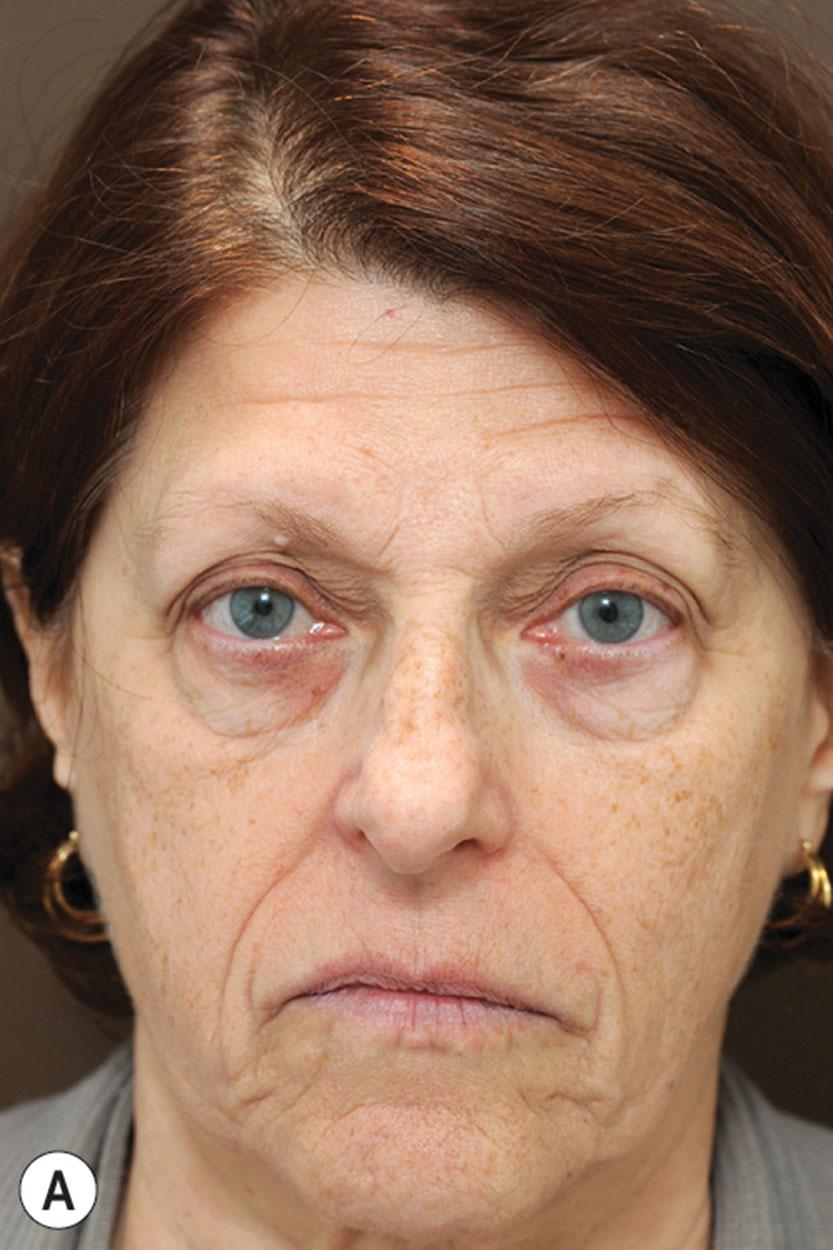
None of these four anatomical traps (low radix or low dorsum, narrow middle vault, inadequate tip projection, or alar cartilage malposition) always requires treatment. For example, the low radix must always be assessed relative to nasal base size: if the base is small, a low radix may create the best balance. But there are cautionary notes. At least one of these four anatomic traits was present in each of the 150 secondary patients in the reported series. Some 78% of the secondary patients and 58% of the primary patients had three or all four of the traits (see Fig. 20.8 ). The most common grouping in both primary and secondary patients is the triad of low radix, narrow middle vault, and inadequate tip projection (40% and 28%, respectively) (see Fig. 20.7 ). The second most common grouping is the association of all four anatomic traits (27% of secondary and 28% of primary patients). None of these anatomic variants is adequately treated by classic reduction rhinoplasty, emphasizing the importance of careful preoperative diagnosis, and including their treatment in the surgical plan as necessary.
For many years, the following concepts provided two explanations for the obstructed nose:
The deviated bony and cartilaginous septum, deformed by congenital anomalies or trauma, may obstruct the nasal airway.
Compensatory hypertrophy of the contralateral inferior turbinate frequently occurs, explaining why both airways are obstructed.
Although many patients with obstructed nasal airways undoubtedly improve after septoplasty with or without inferior turbinectomy, not all do. Adding to the frustration of patient and surgeon are three other common observations: (1) there is often a poor correlation between a patient's symptoms and the apparent site of clinical septal or turbinate obstruction ; (2) patients frequently breathe better (preoperatively and even postoperatively) on the “narrower” side (ipsilateral to the septal deviation); and (3) many patients who have undergone prior successful septoplasty and turbinectomy or who have straight, unoperated nasal septa still complain of airway obstruction.
These apparently inconsistent observations are more understandable if the reader considers airway size to be the product of at least four factors: (1) mucosal sensitivity to the environment or hereditary factors; (2) inferior turbinate hypertrophy from many causes; (3) septal deviation; and (4) position and stability of the lateral nasal wall during the dynamic process of ventilation. Thus, any congenital or acquired weakness or instability of the upper or lower lateral cartilages or their investing soft tissues (which compose the internal and external nasal valves, respectively), along with septal and inferior turbinate size and position, becomes a factor that may profoundly influence the ability to draw adequate volumes of air through the nose.
The internal nasal valve is formed by the articulation of the caudal and anterior (or dorsal) edges of the upper lateral cartilages with the anterior septal edge ( Fig. 20.9 ); the external nasal valve is composed of the cutaneous and skeletal support of the mobile alar wall (the alar cartilage lateral crura with their associated external and vestibular skin coverings). The watershed area between the valves occurs at the transverse portion of the alar crease and at the articulation of the caudal edge of the upper lateral cartilages with the alar cartilage lateral crura.
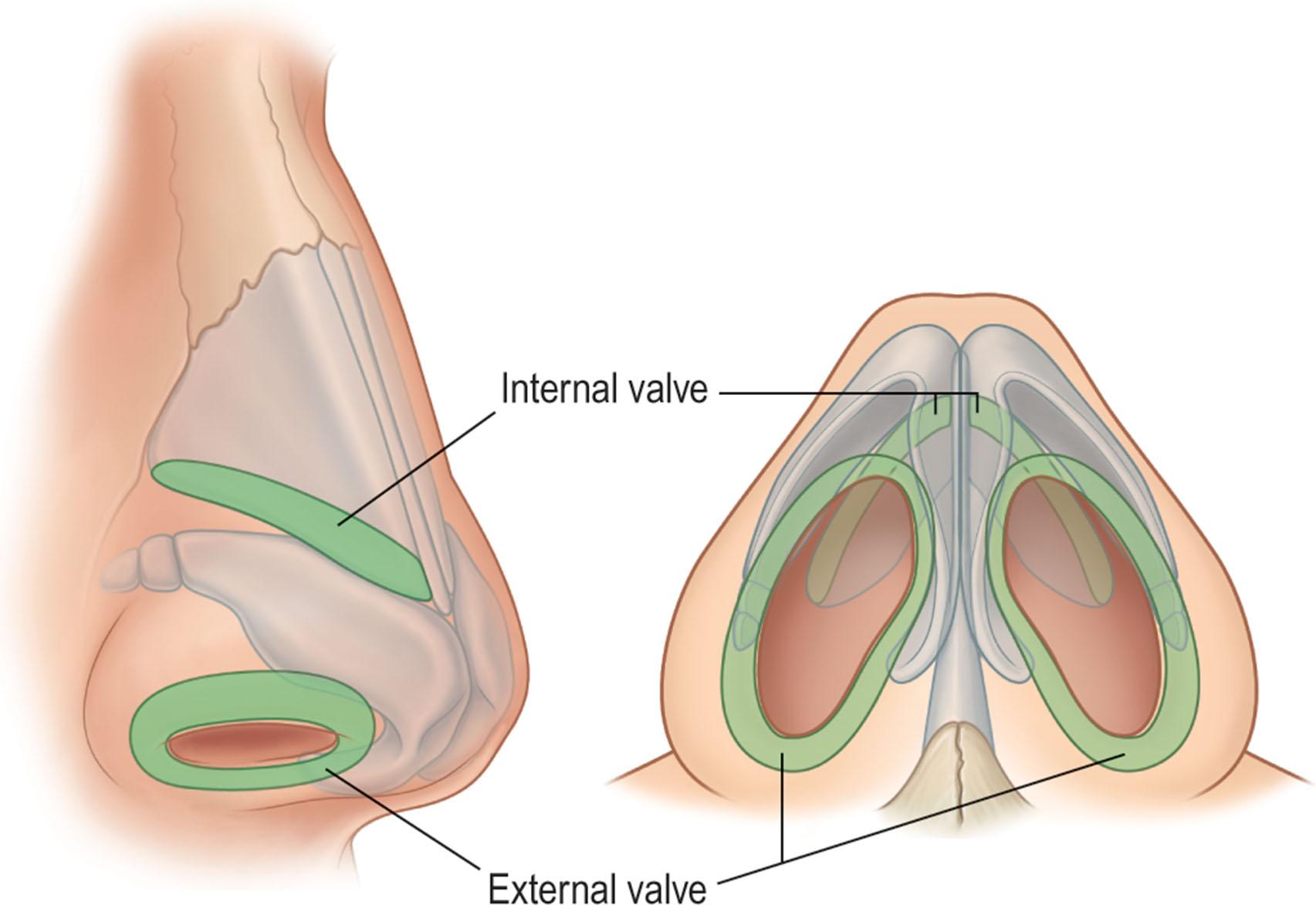
Until recently, efforts to correlate nasal airflow with clinical symptoms had yielded equivocal conclusions. There was argument on both clinical and rhinomanometric grounds that septoplasty either did or did not improve nasal airflow. For such a commonly and easily diagnosed clinical problem as septal deviation, one would expect to find more unanimity in clinical series. These observations were clouded further by the fact that some 80% of nasal septa in the population at large are “deviated” and by imprecision in distinguishing internal from external valvular incompetence. Nevertheless, mounting clinical evidence indicates that obstruction at either set of valves may profoundly obstruct the airway, even in the absence of septal deviation.
Adding to the confusion is the absence of consensus in the literature about whether rhinoplasty itself impairs airflow, which is surprising in view of the number of patients who have postoperative airway obstruction. In fact, the second most common cause for malpractice litigation after rhinoplasty is unrelieved or new nasal airway obstruction (M. Gorney, pers. comm., March 2000).
To help resolve some of these conflicting clinical observations and to provide quantitative measurements of the relative increases in nasal airflow after functional septal or valvular surgery, an ongoing study of 600 consecutive patients undergoing surgery for airway obstruction was undertaken between 1991 and 2008. Patients with septal perforation, atopic patients, and patients requiring turbinectomy were excluded. The diagnosis of septal obstruction or valvular incompetence was made by observation of the nasal airway and nasal sidewall movement with and without a nasal speculum during quiet and forced inspiration. When a flaccid or collapsible valve was supported during inspiration by a cotton-tipped applicator, the patient could usually appreciate an immediate improvement in nasal airflow, thus directing the surgeon toward appropriate operative treatment. Septoplasty and valvular reconstruction by cartilage or bone grafts were performed as indicated. Anterior, active, mask rhinomanometry was performed according to the method of Mertz et al .
That study comprised 600 patients: 78% women and 22% men; 36% primary rhinoplasties and 64% secondary rhinoplasties (median follow-up 14.3 months, mean 27 months). The longer-term data of 362 patients observed for a minimum of 12 months (median 29 months) supported the numbers in the entire group.
The data may be summarized as follows:
Septal and valvular surgery corrected the airway obstruction in more than 95% of patients in a single operation.
Although septoplasty improved airflow ipsilateral to the obstruction, there was no significant improvement in total (geometric mean) nasal airflow after septoplasty alone.
Internal valvular reconstruction by dorsal or spreader grafts doubled nasal airflow.
Spreader grafts and dorsal grafts were equally effective in supporting the internal nasal valves.
External valvular reconstruction doubled mean nasal airflow.
The largest postoperative improvement was seen in patients after correction of both internal and external valvular incompetence (more than four times preoperative values).
Septoplasty in addition to valvular reconstruction did not significantly improve nasal airflow over the results obtained by valvular reconstruction alone, even in patients observed more than 100 months postoperatively.
These results were produced without performing inferior turbinectomy in any of the patients.
In those patients with lateralized symptoms, the septum was contralateral to the more obstructed side in 45% of cases.
Of the 384 secondary rhinoplasty patients, 94% had previously undergone an adequate septoplasty but were still symptomatically obstructed. Within this group, valvular reconstruction alone corrected the airway in 97% after one operative procedure.
When primary and secondary rhinoplasty patients were stratified, the improvement in primary patients equaled or exceeded the improvement achieved in secondary rhinoplasty patients in six of the eight obstructed sites examined.
Valvular obstruction was 4 times more common than pure septal obstruction in primary rhinoplasty patients and 12 times more common than pure septal obstruction in secondary rhinoplasty patients.
When the entire 600-patient group was stratified, the greatest improvement was observed in those patients observed for more than 12 months, supporting the view that the airway continues to enlarge as edema resolves.
By measuring airflow during quiet and forced inspiration, sidewall stiffness could be quantified and shown to increase following valvular reconstruction by dorsal, spreader, or alar wall grafts.
A decrease in nasal airflow following rhinoplasty was not obligatory, even in patients with preoperative airway obstruction.
In conclusion, current rhinomanometric data support the concept that lateral nasal wall movement caudal to the bony arch (containing both the internal and external valves) constitutes a cause of airway obstruction equal to or greater than septal deviation in most rhinoplasty patients. By visualizing the airway as a structure in which the septal partition forms one side and the mobile lateral nasal wall forms the other, and in which the turbinates and mucosa function as additional dynamic structures, the inconsistencies in prior clinical observations become easier to explain. Inspired airflow passes through the nose at 15–65 km/h, the latter equivalent to gale force winds. The size of any nasal airway thus depends not only on the position and configuration of the septum and turbinates but also on the stability and competence of the nasal valves under significant transmural pressures. The observation that patients often breathe worse on the side contralateral to the septal obstruction (45% of our patients with lateralized obstructions) can therefore be explained through valvular incompetence. In patients with septal deviation and valvular incompetence, the side with the greater airflow and greater transmural pressure (i.e., the side contralateral to the septal deviation) will collapse first and therefore be more symptomatic.
This study did not answer the question of where turbinates fit into the hierarchy of nasal obstructions. In atopic individuals with gross turbinate hypertrophy or polyps, turbinectomy is unquestionably valuable. However, the mean nasal airflow improvements listed above were achieved without turbinectomy, even in a population of patients with secondary deformities, valvular incompetence, prior intranasal scars, webs, or vestibular atresia, suggesting that turbinate obstruction in many patients may be largely reactive or secondary and that radical turbinectomy may not often be necessary if septal and valvular factors have been addressed properly.
Resection of nasal lining, alar cartilage malposition, excessive alar wedge resection, and inadequate or excessive nasal shortening may also obstruct the airway.
Two principles underlie the logic of reduction rhinoplasty, neither of which is always valid:
FALSE ASSUMPTION NUMBER ONE: The nasal soft-tissue cover has the infinite ability to contract to the shape of any underlying skeleton.
This assumption is the basis of open rhinoplasty: a great skeleton means a great surgical result; the entire result depends on whether this assumption is valid. However, the nasal skin is not passive; it contracts according to its quality, thickness, and preoperative distribution, and not necessarily to the shape of the surgically reduced skeleton. The vectors of skin sleeve contraction are related to, but independent of, the volume and contour of the underlying skeleton; the end stage of these vectors is the classic shape of supratip deformity (see Fig. 20.1 ). If this assumption were always true, supratip deformity would never occur and augmentation would never correct it. Inability to judge soft-tissue contour and movement is one of the largest handicaps to the surgeon performing open rhinoplasty.
FALSE ASSUMPTION NUMBER TWO: Alterations in the nasal skeleton produce purely regional changes.
The classic application of this assumption is the common strategy in which the surgeon plans to resect all nasal dorsum anterior to a straight line drawn from the nasal radix to the point of the tip ( Fig. 20.10 ). Underlying this strategy is the assumption that dorsal reduction affects bridge height alone. Changes in the nasal skeleton are not independent, however, but rather have global effects outside their areas. For example, resection of the nasal bridge affects nasal width and length, apparent nasal base size, middle vault support, alar rim contour, and columellar position, most dramatically illustrated in examples of septal collapse (see Fig. 20.5 ). Similarly, alar cartilage reduction can affect tip support and projection, nasal length, alar rim contour, and external valvular support. These structural interdependencies are not just regional. Recognizing them is necessary to preoperative planning, interpretation of intraoperative nasal appearance, postoperative success, and the correction of secondary deformities ( Table 20.2 ).
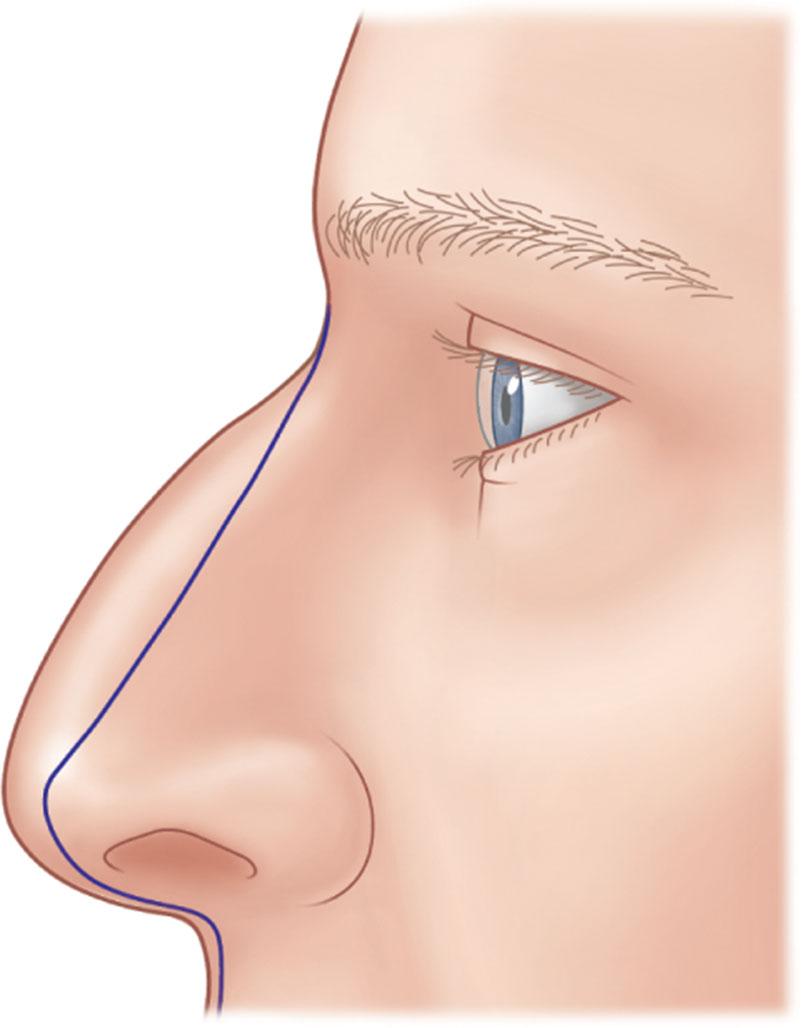
| Nasal structure | Location of effect | Possible surgical maneuvers |
|---|---|---|
| Dorsum | Length, base size, nostril contour Columellar position, middle vault (internal valves) |
Reduce/augment Place spreader grafts |
| Upper lateral cartilages | Nasal length | Resect |
| Caudal septum | Length, subnasale contour, lip carriage | Resect, augment, augment maxillary arch |
| Alar cartilages | Columellar contour, tip projection External valves |
Resect, relocate, augment |
Although rhinoplasty presents unique difficulties for the surgeon, it is difficult for the patients as well. Those surgeons who have seen secondary rhinoplasty candidates devastated by the results of one or more prior operations should immediately recognize the importance of a safe and biologically sound surgical plan and of an accurate understanding between patient and surgeon of the aesthetic goals and the realities of the surgical problem – that is, what is possible and what is not.
Making the interview more difficult is the prevalent misconception that many patients hold about their nasal deformities and therefore about the corrective plan. Many patients do not recognize that a simple nasal reduction may not achieve their goals. Patients without airway obstruction do not appreciate the importance of maintaining nasal function, and most do not realize that routine dorsal and tip reductions will jeopardize the airway.
The patient must therefore be guided to understand that every rhinoplasty is a compromise between the patient's preferred aesthetic goals and the limitations that a predetermined preoperative skeletal and soft-tissue configuration imposes. Donor materials vary in quantity, character, and composition, determining their usefulness. Finally, many preoperative noses already have some desirable features; patient and surgeon should be careful not to destroy them.
It is important to elicit the patient's goals in the greatest possible detail and to prioritize them. The patient defines the normal for him or her and therefore the aesthetic goals and surgical plan . Is the major issue bridge height, tip projection, nasal length, asymmetry, or airway? How long has the sense of deformity existed? This latter question is more critical in older than in younger patients: the 60-year-old patient who has disliked her nasal shape for 40 years may tolerate a larger change than will one who has been troubled for only 5 years and who may be noticing only signs of recent aging.
For any patient older than 14 years, I often interview and examine the patient alone (in minors after parental permission), before involving the family, spouse, or others of significance in the discussion. Although some protective family members or spouses initially object to this policy, it is important to establish an individual relationship with the patient and to hear his or her concerns and complaints free of outside influences. Excessively protective family members who try to dominate the conversation and the surgical plan can be signs of immaturity in the patient or boundaryless behavior in the family, both of which may contraindicate surgery. An excessively controlling family member invariably distracts the patient and can make it impossible for the surgeon to obtain a good history or establish a personal connection with the patient. Childhood abuse and neglect are not only common in our society but also in plastic surgery patients because both affect body image and body shame (see below).
When the patient has had prior surgery, it is important to obtain a careful chronology and, if possible, photographs that reflect the preoperative appearance. Such pictures provide information about the prior surgeon's goal and how the current deformities may have occurred and place the patient's original objectives in current perspective. For the younger surgeon, a comparison of preoperative photographs to outcomes is invaluable and teaches an enormous amount about the consistencies and variabilities of nasal skeletal and soft-tissue responses to surgery. Be particularly wary if the original nose was normal, i.e., straight, symmetrical, and without airway problems, and the patient knew it. The surgeon must fully explore the motivation for the original surgery and determine whether body shame or body dysmorphic disorder exists.
Inquire about the airway first to avoid becoming distracted by the patient's aesthetic considerations. Patients become used to a poor airway. Many have never breathed normally; others have lost their basis for comparison after trauma or previous surgery and have forgotten how much better their airways used to be. Ask about periodic or cyclic airway obstruction; which airway is worse; any nasal trauma history that may alert the surgeon to an occult septal fracture; seasonal allergies that obstruct the airway; clear rhinitis; episodes of suppurative sinusitis; snoring, epistaxis, and nighttime obstruction; frequent nose blowing; and what non-surgical remedies the patient has previously tried. Not infrequently, secondary rhinoplasty patients with poor airways chronically self-medicate with steroid or vasoconstrictive sprays that must be eliminated before surgery. Also important are the patient's work environment and a history of tobacco or alcohol consumption (either of which may cause nasal congestion) and, more important now than in previous years, cocaine use. Finally, inquire about any nasal areas that the patient does not wish altered and, if appropriate, whether a change in personal, familial, or ethnic characteristics is desired.
Primary and secondary rhinoplasty patients differ in three characteristic ways. First, the secondary patient's scarred, contracted soft tissues will not tolerate aggressive dissection, multiple incisions, wound closure under tension, or tight dressings. Open rhinoplasty confers a significant hazard in the secondary or tertiary nose, despite the enthusiastic contrary claims of its advocates. Biological laws are consistent. Any surgeon who examines revision rhinoplasty patients will see many who have had segmental columellar soft-tissue losses, areas of secondary healing, prior skin grafts, or failure to achieve adequate tip projection because the columellar incision could not be closed. The logic that the worse the deformity and scarring, the more aggressively surgeons should open the nose is faulty and defies surgical principles respected everywhere elsewhere in the body.
Second, graft donor sites may have already been harvested, necessitating the use of more difficult (distorted septum or concha), painful (costal), or frightening (calvarial) donor sources. Third, the secondary rhinoplasty patient's morale is often more fragile. Having already invested money, time, discomfort, and emotion in one or more unsuccessful procedures, what secondary rhinoplasty patients fear most and need least are additional disappointments. The surgeon must construct a plan that is based on a clear understanding of what is possible and founded on sound surgical and biologic principles that maximize the airway and respect the patient's aesthetic goals.
It is wise to make a habit of examining the internal nose first so that this most critical functional area is not forgotten in an urgent discussion of aesthetics. More importantly, the surgeon must avoid unintentionally decreasing postoperative nasal function; this occurs more often than is recognized and poor airways dominate the complaints of secondary rhinoplasty patients. The internal nose should be examined without manipulating the airway by asking the patient to breathe deeply and observing areas of collapse or asymmetry in the nasal sidewalls, high septal deviations, distortion of the columella, protrusion of the caudal septum, or alar rim collapse.
Sidewall collapse with inspiration at one or both of the nasal valves is surprisingly common. It is important to determine why valvular incompetence exists (e.g., prior surgery, short nasal bones, a congenitally narrow middle vault, intrinsic weakness, or alar cartilage malposition). If sidewall collapse occurs, occlude one nostril and ask the patient to compare flow through the unobstructed airway with and without supporting the collapsing area with a cotton-tipped applicator soaked in 1% pontocaine hydrochloride for the patient's comfort. Patients with valvular incompetence will immediately notice an obvious increase in airway size. The surgeon may observe valvular collapse and substantial airway obstruction even in the patient with a straight, unoperated septum and without turbinate hypertrophy. Here, septoplasty may be indicated to harvest grafts but by itself will not open the airway; the surgeon must also place spreader, dorsal, or alar wall grafts. Reconstruction of the internal and external valves can triple or quadruple airflow in most rhinoplasty patients, even when septoplasty is not simultaneously performed.
The septum should be palpated for substance, contour, and mucosal cover (indicating the sequelae of allergy, injury, perforation, or chronic cocaine use). It is also important to assess whether a “high” (i.e., toward the anterior or dorsal edge) septal deviation exists; because hump removal can unmask a high septal curvature, the surgeon should be prepared to camouflage or correct the septal deflection with unilateral or asymmetrically thick spreader grafts.
Clinical and rhinomanometric data indicate that obstructing turbinates are relatively low in the hierarchy of common airway obstruction causes in primary and secondary patients. Because turbinates warm and humidify inspired air, the surgeon should plan conservative resections even in atopic patients. Furthermore, histologic studies have shown that turbinate hypertrophy secondary to septal deviation is characterized by bony, not mucosal overgrowth. Therefore, most patients who have had good septal and valvular reconstruction can be adequately treated by only turbinate crushing and outfracture (or no treatment at all).
Palpation of the external nose provides important information about cartilaginous size and substance, bony vault length, nasal sidewall stiffness (another assessment of valvular support), and soft-tissue thickness. Tip lobular contour is considered, as is the balance between nasal base size and bridge height (see below). The patient is asked to discuss each nasal area, whether or not it has been mentioned previously: width, length, bridge contour, tip shape, nostril size, columellar and upper lip position, and any asymmetries.
Between the external and internal examinations the surgeon can make all necessary diagnoses so that the entire operative plan can be written out preoperatively and followed. The only intraoperative decisions are thus quantitative, not qualitative, and depend on graft and soft-tissue substance and texture. It is not necessary to find every hidden nasal structure. Anatomy that cannot be seen and that is not blocking the airway may be an interesting anatomical curiosity, but finding it has no value to the patient. Limit dissection only to those areas that require change.
On frontal view, the upper nose should be narrower than the lower nose; symmetric, confluent, divergent lines should connect the two; alar base and tip lobular width should balance. The alar sidewalls should be convex, not flat; ablated nasal topography and highlights create a surgical appearance. On oblique view, there should be no regional discontinuities, the supratip should be flat, and tip lobular mass should fall below the levels of the peaks of the alar cartilage domes. On lateral and oblique views, nasal length and base size should balance each other. Ideal parameters have been suggested. The practical difficulty in employing many of these guidelines lies largely in the facts that skin sleeve volume and distribution have already been predetermined and that skin contractility is limited, not infinite. Furthermore, ideal aesthetics do not apply to most patients, even those with Caucasian features. If the surgeon had the latitude of reducing skin volume, the size of the postoperative nose could be altered more radically to a patient's facial measurements, body habitus, or other parameters. In practice, however, the surgeon works within narrower limits. It is not possible, from the same preoperative nose, to create a small nose for a short patient and a larger nose for a tall patient. Skin thickness and distribution have been predetermined. The airway should be patent and stable on forced inspiration. Beyond these basics, the details depend on the patient's skeletal framework and soft-tissue cover and their goals. Rhinoplasty offers, as much as or more than, any other aesthetic procedure, the possibility of individualizing an aesthetic outcome.
Good preoperative photographs are imperative for the consultation, formulation of an operative plan, and intraoperative guidance, not cell phone images taken on the way to surgery. The patient's photographs should be available before the preoperative visit so that the operative plan on which surgeon and patient have already agreed may be reviewed or modified. Photographs should include full head and close-up frontal views, both oblique views (which often differ, particularly in patients with nasal asymmetry), both lateral views, and an inferior view. Photographs are best taken with a portrait focal length lens (90–105 mm) against a medium–dark background, lit so that symmetries and contours will be depicted accurately. Camera-mounted flash units are inferior to studio systems with umbrella lights or wall-mounted strobes to provide backlighting and to illuminate the face and hair.
Because practical rhinoplasty strategies may differ from what patients imagine, the patient must understand the logic of the surgeon's plan and prefer it to other reasonable alternatives. Unless the surgeon only plans to reduce the nose, he or she must help the patient understand the benefits of equilibrium or conservative reduction; to this end, words like “balance” and “proportion” often serve better than terms that signify only size. It is best to be specific about the plan down to the last graft and choice of donor sites; this candor places patient and surgeon on the same side of the problem and also ensures that postoperative imperfections are more likely to be tolerated by the patient, who understood the necessity of each surgical maneuver beforehand. Recognizing the rationale for grafting is more difficult for primary than for secondary patients; the latter, who have already seen the effects of reduction and disequilibrium on their nasal configurations and airways, are often easier to convince.
Patient and surgeon alike must remember that revisions may be necessary – and almost predictable in some difficult configurations if the best possible result is desired. Revisions are frequently minor, but all patients should understand preoperatively what cannot be predicted and therefore not mistake the uncontrollable for the uncontrolled. Revision should rarely be undertaken until the end of the first postoperative year. It is my practice to provide a written surgical plan to each preoperative patient that includes percentage chances that revision may be indicated for the best possible result. This is not risk management; it is patient education. Resolution of swelling and stabilization of the final appearance take at least that long in the primary nose and often longer in patients undergoing secondary rhinoplasty. Nothing should be done until healing is complete and the tissues are supple. The surgeon should control every possible variable.
Who should perform the revision ? To some degree, the answer depends on the same factors involved in the prior rhinoplasty. The surgeon's model and proposed solution should be clear, and the patient's goals reasonable; patient and surgeon must understand each other explicitly. Each operation is more difficult than the last.
What limits the applicability of most proposed aesthetic ideals is the character, volume, and distribution of the skin sleeve and the limitations that they impose. Three soft-tissue parameters can be used to form any rhinoplasty plan, and they will therefore apply to both primary and secondary patients.
Become a Clinical Tree membership for Full access and enjoy Unlimited articles
If you are a member. Log in here